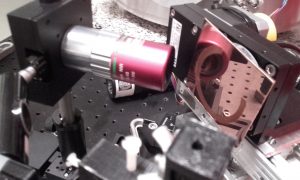 Low-energy laser pulses produced at L2A2 (1 mJ, 25 fs, 1kHz), efficiently focused (~ 10 μm2) on different target materials, generate a plasma where electrons are accelerated up to some tens of kiloelectronvolts. The interaction of these electrons with the same target material generates X-rays within the same range of energies. The advantage of these new X-ray sources, with respect to conventional ones, is the micrometric size of the focus. Under such conditions one can produce X-ray images with much better quality and lower doses. Moreover, one can also produce images not only based on the simple absorption technique, but also taking advantage of the phase of the produced X-rays, the so-called “phase-contrast imaging”. This technology provides an additional sensitivity to the density of the exposed object, which is particularly interesting for biological samples.
Low-energy laser pulses produced at L2A2 (1 mJ, 25 fs, 1kHz), efficiently focused (~ 10 μm2) on different target materials, generate a plasma where electrons are accelerated up to some tens of kiloelectronvolts. The interaction of these electrons with the same target material generates X-rays within the same range of energies. The advantage of these new X-ray sources, with respect to conventional ones, is the micrometric size of the focus. Under such conditions one can produce X-ray images with much better quality and lower doses. Moreover, one can also produce images not only based on the simple absorption technique, but also taking advantage of the phase of the produced X-rays, the so-called “phase-contrast imaging”. This technology provides an additional sensitivity to the density of the exposed object, which is particularly interesting for biological samples.